Below is an essay I wrote after interviewing artist Richard Kurtz last month, and diving deep into insider/outsider/whatchamacallit art which I have been interested in for some time. His work will be featured at the New York Outsider Art Fair in New York this month (January 18 – 21). Please visit Booth 19 should you find yourself there. Meanwhile – let’s dissect the idea of outside art. Peace – c
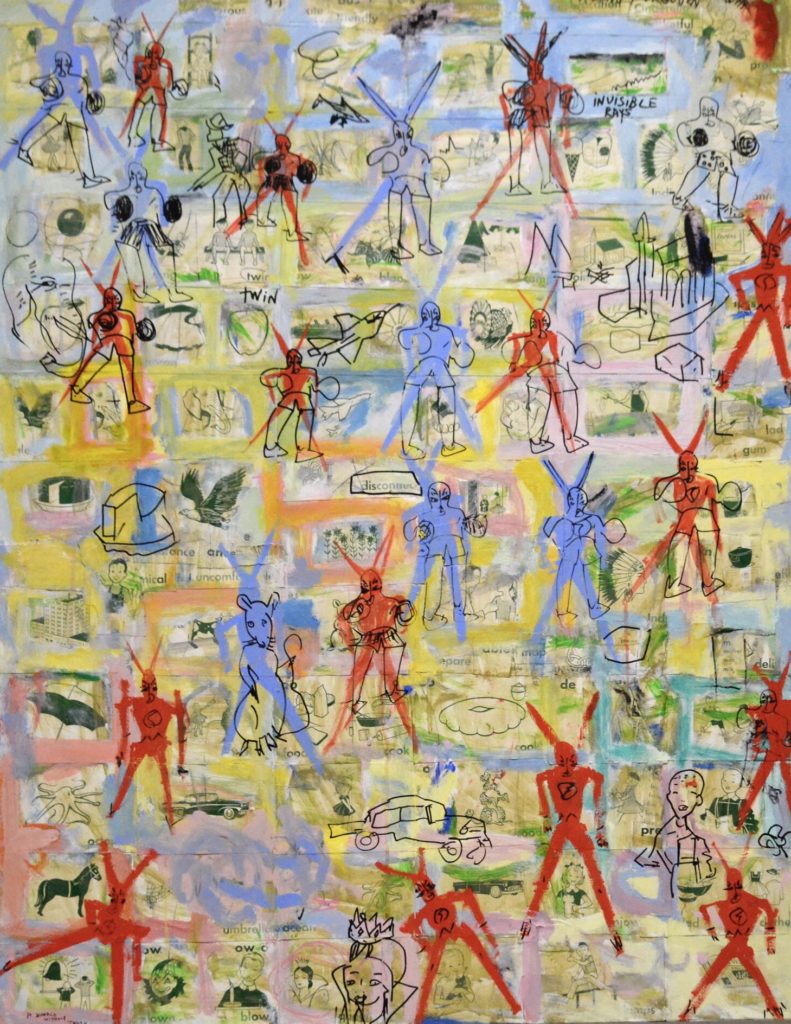
“Invisible Rays” … Mixed Media Painting on Linen 42×54, image courtesy of the artist Richard Kurtz and Esperanza Projects.
“Perhaps there is more sense in our nonsense and more nonsense in our sense than we care to believe.” – David Bohm
Living a life well lived as a sensitive soul is not for the faint of heart. One must tack and jibe based solely on our heart and our gut, with our minds trailing behind. Duchamp led with his head first. Outsiders lead with everything else first – their touch, their eyes, their gut, their smell, their material. When discovering artists such as Richard Kurtz, we mustn’t fetishize a mental disorder or anguish, or draw a parallel to countless other artists who were obsessed with boxing. Instead we must celebrate the sensitive and the spiritual aspects of the work. Few artists dare to tread in this space.
Art Brut, or raw art as it’s translated from French, was first termed years ago by Jean Debuffet upon starting a collection in 1945 of said work. At the time he was looking at children’s work, psychiatric hospital patients’ work, and work from prisons. He was not the first to explore art unfettered by cultural norms and the fertile plains of madness, Dr. Walter Morgenthaler published his book Ein Geisteskranker als Künstler (A Psychiatric Patient as Artist) in 1921.
Dubuffet defined raw art as “Those works created from solitude and from pure and authentic creative impulses – where the worries of competition, acclaim and social promotion do not interfere”. Outsider art as it became known continued to revel in the concept of artist as an island and removed from society. This, by the way, parallels the romantic notion of the artist’s personality cultivated by Courbet 160 years ago.
Outsider art continues to welcome new terminology (e.g. visionary art, self-taught, Intuitive Art, Neuve Invention, Naïve art), all for the service of knowledge capture and art marketing to a degree. For the sake of truly understanding Richard’s work, and many of the outside art work, I suggest we consider less the outside art and see it as more firmly the inside art. The inside completely in cahoots with and reflecting the chaotic messy side of the spirit or consciousness that resides in all of us. Art and spirit is mingling in the work of outside artists, whether self-taught, disabled, living as a recluse etc. The topic of spirituality is not something academics care to wrestle with, so outside art is the magical bucket to place the work. In reality the outsider’s work is truly inside art.
Dare I say that all of these artists, whether Richard Kurtz, Judith Scott or Morton Bartlett, are deeply spiritual, and ride the wave of the unconscious, something that would terrify most people. I’m so grateful their edit button is soft and rarely used so the materials are given full spectrum without being cooked by museums, art schools or galleries. Deeply spiritual work also means deeply authentic. By authentic I mean they make work only to satiate the moment and not a masterpiece. On no uncertain terms these artists survive through and because of their art.
A reaction to polite convention was once the space of the outside artist. The general population now resides in a polluted and impolite convention, so clearly the outside artist must react to that – and what does that look like? Social restraints are the demons now that people wrestle with anonymously or quite publicly in the internet universe – so are outside artists struggling with their inner demons, or are they sharing their inner peace? In Richard Kurtz’s work could that be the peace of accepting both the male and female within us? Or a full frontal exploration of being a heterosexual male? This is, by all polite conventions these days, the place of an outsider.
SEXUALITY
Unlike the overblown, male-centric sexuality of say Josef Hofer’s drawings, Richard’s male characters are dressed with boxing gloves, and the women are covered in lingerie. Body decoration has a history in Art Brut, in the sense that Jean Debuffet collected prisoners’ tattoos for his Collection de l‘Art Brut in Lausanne. I’m guessing they are not fully nude in Richard’s work because there is an art to seduction. The power in hiding your cards is real whether you are boxing or seducing.
Much of raw art is focused on the body, it is a cage or a haven of complex intimacy. In Richard’s work it seems less a cage and more a space where energies need to be released, transformed and shared. The body in his work is prominent and unapologetically male. The continuously repeated characters of super hero, prize fighter and seductress are the ever present language in heterosexual men ages 4-100. They are the pillars of a universal power struggle of the sexes through the eyes of a man. While we are a more evolved society at times, where we understand our sexuality plays out on a spectrum, Richard’s work sits fiercely in the corner of the ultra-male. And by ultra-male I mean the male that sits with all of his perceived power, yet holding an incredible amount of vulnerability just below the surface.
A parallel could be made for sake of understanding to a female artist such as Sophie Calle. Her conceptual work is ultra-female, where she obsessively writes in diaries, shares her love affairs and creates exquisite drama as only a woman knows the art of, and courageously bares her heart, her fantasies and feelings. As an audience we are rewarded with this utter exposure and at times obsession, in the same way that we are with Richard’s work. She bears witness via conceptual work, while Richard does so in a gestural painterly way and from a male’s point of view. Is it any wonder Ms. Calle is a collector of his work?
REPETITION
Richard’s work carries some serious threads. While over the years he has buoyed his practice and his unconscious to superheroes, boxers or seductive ladies, the one true thread is the art of repetition in his work it seems. In conversation with me he revealed that indeed these characters are his stretching he does in the studio, a mandatory practice. The stretching is required, just as it is in a yoga studio or a gym, to let other characters and compositions in. Much like if you stretch before a workout that could enable more mileage or more aggressive moves – these are the characters that ground him in the studio. The thread overall is the repetition. Repetition is powerful, it is revealing, and it is a form of meditation.
Freud has famously analyzed repetition as compulsion, an obsessive repetitive behavior that is disguised as a reenactment of repressed trauma. That said, repetition is also used as a technique for the spiritually meditative. Many religions (e.g. Christianity, Judaism, Islam) have used the repetition of gesture and words to draw the mind inside away from everyday life.
The repetition in Richard’s work makes sense as a stretch if you will, he does have other work unrelated to these characters. I also think it’s a complex personal choice, a choice made to threaten the proliferation of chaos. A way to stay grounded and not float too deep in the inner world.
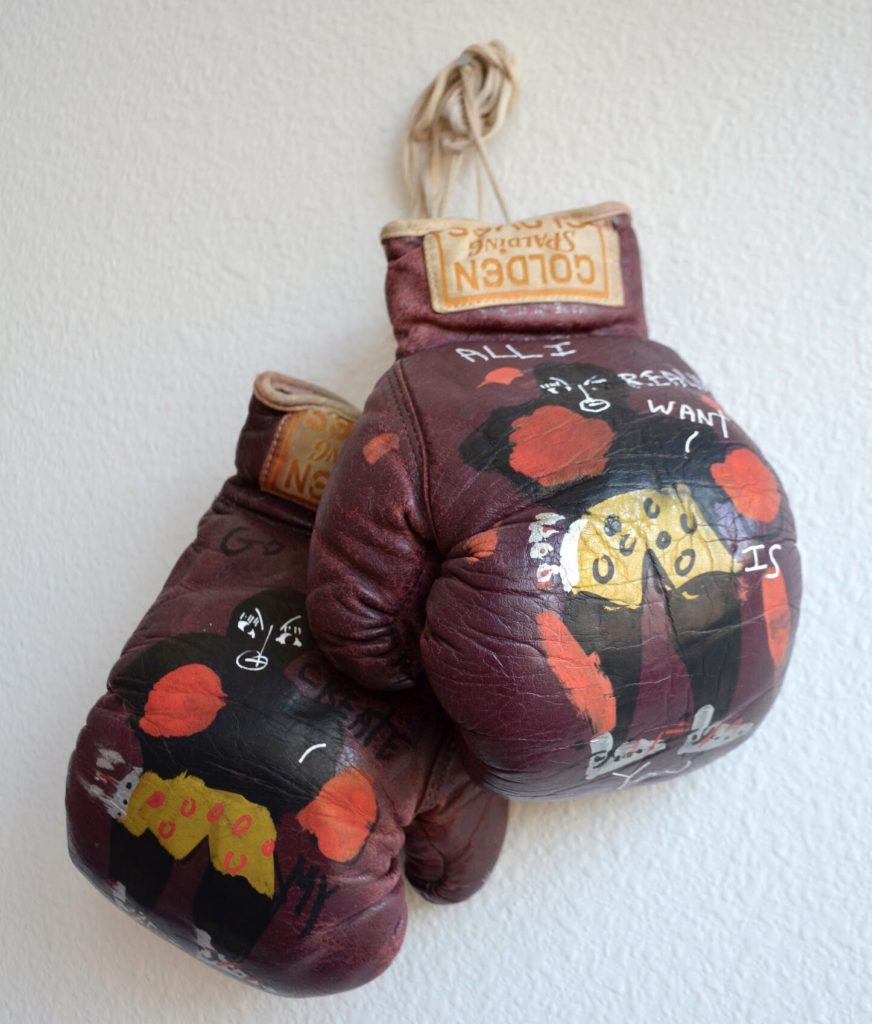
“All I Want Is You”, casein on found vintage Golden boxing gloves, courtesy artist Richard Kurtz and Esperanza Projects
BOXING
“For me, the image of the boxer is a warrior—a hero. We all have to fight to remain conscious and present. It’s like in life, you blink, you lose.” – Richard Kurtz, from the “Faces and Figures” exhibition documentation at Vassar College
From his youth in the East Village in New York City to the luchadores in Mexico, Richard has continually participated in boxing – as exercise, as spectator and as metaphor. No sport has enjoyed the poetic ties with artists and writers as much as boxing has. TS Elliott took boxing classes at Harvard, Jack London engaged in professional boxing matches, and Ernest Hemmingway started his book The Sun Also Rises with a description of a boxer and his pending match. Japanese Neo-Dada artist Ushio Shinohara famously performs his boxing paintings, Basquiat sprinkled images of boxers into his work, and George Bellows’ gritty realism celebrated amateur boxing and the urban life of New York City in the 1920’s.
The key, especially in Richard’s work, is that the boxers have nothing to do with violence and everything to do with self-knowledge. Boxing is inextricably tied up with our culture’s perception of manhood, and the paintings are a way to debate that issue. Years ago Richard had seen a young Muhammad Ali on the boardwalk in Atlantic City. He was dressed well and walking with a group of men. At that time, he had given up his boxing career to follow his beliefs. As a young child of 13 Richard was inspired by Ali for choosing this path – the strength to take a position that would strip him of his iron status in order to support his beliefs. This inspired Richard later in life to create a series he called Hero.
When Richard later lived in Mexico, he would travel by bus to Mexico City to watch the luchadores. An entire series of work was created at this time. The luchadores are professional wrestlers in Mexico that wear demon masks, use aerial moves and are more freestyle than typical US wrestlers. Considering the history of machismo in Latin culture, an exaggerated masculinity and masculine pride, it’s no wonder Richard was attracted to this sport during a period of extreme self-reliance in his life. While on first blush the work is about the sport, the work is more honestly about survival.
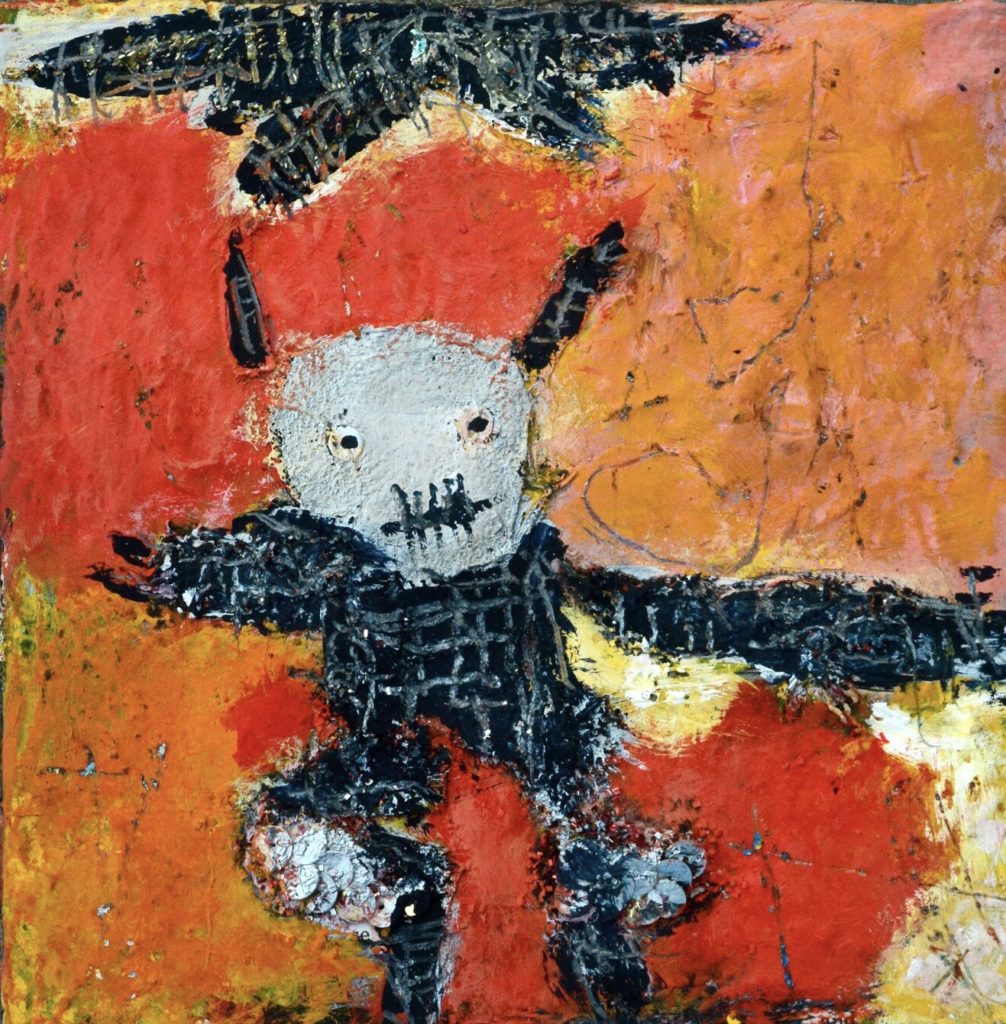
“Little Monster”, mixed media painting on board, image courtesy the artist Richard Kurtz and Esperanza Projects.
BIO
There is no way to create a reader’s digest version of Richard’s life. He has lived comfortably in youth, been homeless, had breakdowns, moved to different countries, was a limo driver where he drove Andy Warhol, Keith Haring and Jean-Michel Basquiat, and he has shared a studio with chickens in Little Haiti, Miami. The details are fascinating. Gene Hackman shared canvases with him when he couldn’t afford them, Martin Scorsese attended one of Richard’s shows while he was working as one of Scorsese’s assistants during the filming of the movie “After Hours”.
In New Mexico he owned an organic restaurant, and after 12 years he lost everything, walking away with $500 and a Volvo. He then lived in his car for five years, and had studios when he could. It was during this time when he found NRA Target papers on a sidewalk and the boxing paintings were born on these found objects. He then started painting on Starbucks cards and expired credit cards. Much of his work continues to land on found objects that carry both a tactile quality and a connection to Richard. He paints on found dictionaries, children’s books, luggage, and bank ledgers to name a few. All chosen for their tactile quality and because they speak intuitively to him.
He moved on to Miami, where he sought out Purvis Young, an artist whose work he admired. Purvis gave him wood panels to paint outside his studio in a parking lot. During this time, he also painted guerilla murals and worked on a mural project with children in Little Haiti. His studio spaces he moved in and out of included a space in the former Stash Gallery in Little Haiti and the Villa Paula, a notoriously haunted building in Miami.
Richard then landed in Santa Fe where he met Jennifer Esperanza, who became his partner, travel companion and one of the most pivotal proponents of his work. Initially Jennifer shared her kitchen table with Richard for his studio, and she continues to be the flashlight shining on his work, bridging his work with the public though building his web site, marketing materials and general outreach. The two now live in Oxnard, California where he has a studio and has been continually painting his boxers, superheroes and seductresses, and often on luggage no less inspired by his nomadic past, and perhaps future.
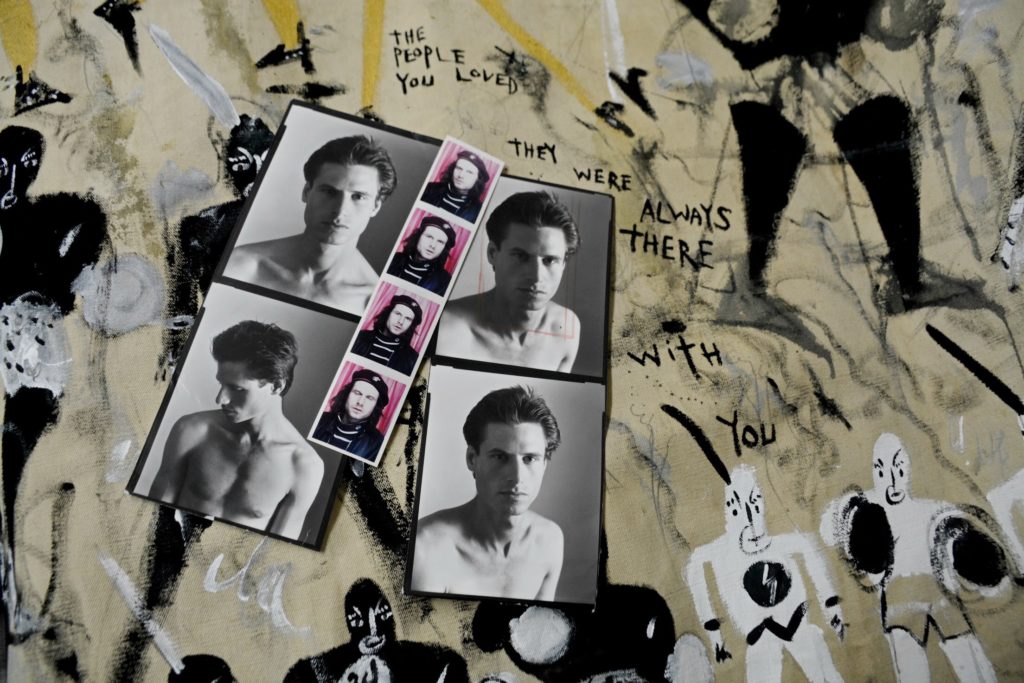
Richard Kurtz studio photos NYC early 1980s, and photo booth photos Santa Fe, NM 1990, image collage courtesy of Esperanza Projects.
EVOLUTION OF WORK
Richard began in the early 80s in New York City’s East Village with an interest in photography. After seeing a show at the MOMA called “Mirrors and Windows, American Photography since 1960”, he consulted the phone book and proceeded to call the photographers whom he admired in the show. While some answered, the only that invited him over was Tetsu Okuhara. Richard quickly became his assistant and friend over the course of several years. The painting came later as a necessity – a tool for self-awareness and reflection. Photography feels precise, like surgery on reality, painting is the magic as Walter Benjamin alluded to years ago. While having a base in photography, Richard continues to work exclusively in the painting and drawing medium.
IN SUM
In his artwork Richard manipulates a language that while many of us feel it, he has the gift to make it visual. Instead of calling the mirror of the outside artist broken or distorted, it’s actually a more vivid reflection. From the vantage point of Richard’s studio, art is meant not as a means of escape but as a means to sustain oneself.
While the rest of us wander to the therapist office, order the pills, eat too much, stay up too late, etc. the outside artist wrestles smoothly with the inside, with the subconscious and with unforgiving reality. There needs to be a new lens on this idea of outside art. In the past many with isolated and urgent fantasies may have been relegated to the prison or insane asylum. Many are now perfectly functioning members of society. It is the rare minority that elevates the symptom or isolation or schism, and uses art to make peace with it. Outside artists should be celebrated as an example for healing, for honest exchange, and for true freedom.
Outside artists have historically been described as living in their own world that is private and rarely overlaps with those of others. They were described as being outside of and indifferent to the conventions that govern social behavior. The facets of this definition could easily be replaced with describing not outsider artists but the typical citizen of the internet and new virtual world. Like the outside artist of the past, we now live private, non-overlapping lives while creating our own carefully curated bubble of information and conventions. Could Richard Kurtz, and artists like him, operating outside the lines and systems, be an example to us? Showing us a way to quell the anxiety of the separation by making artwork drawn from our guts, and lowest chakras. Can we still find that area?
The work of Richard Kurtz can be found in numerous private and public collections including, Audrey Heckler, The Blanchard-Hill Collection, Sophie Calle, Blake Byrne, The Museum of Everything and the de Young Museum. He has shown with Laura Steward at the Paris and New York Outsider Fairs. His work has been included in such notable shows as, Faces and Figures in Self Taught Art at Vassar College and My Big Black America at the Corridor Gallery in Brooklyn, New York.
Tagged: Art Brut, Art of Repetition, art practice, Boxing, Insider Art, New York City, Outsider Art, Outsider Art Fair, painting, Repetition, Richard Kurtz
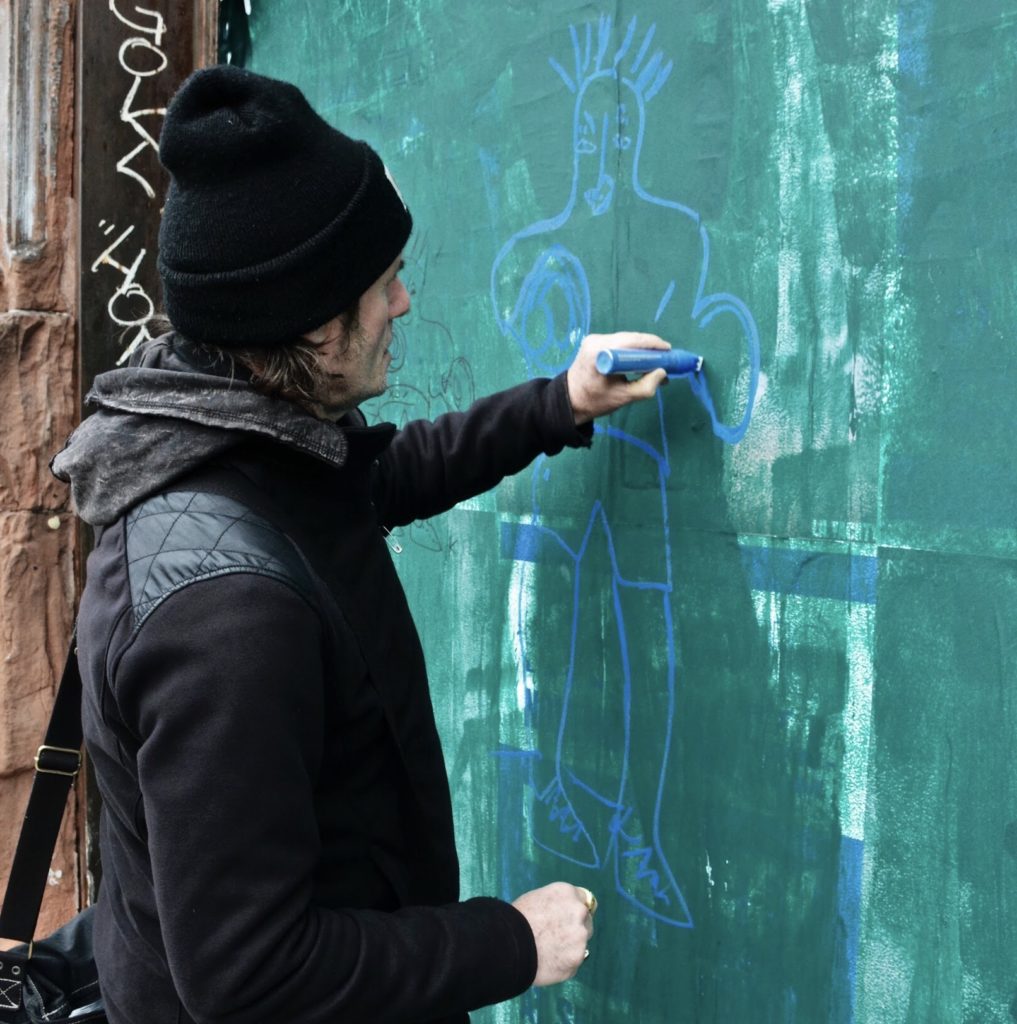
10 Comments
Jennifer Esperanza • January 2, 2018
Thank You for this beautiful piece on Richard.
Esperanza Projects
Catherine Haley Epstein • January 2, 2018
An absolute pleasure to do. Richard's generosity in sharing his work and evolution as an artist is an inspiration to me, and many!
Mark Belote • January 2, 2018
I was seduced by the paintings, but the sculpture and objects ie. the boxing gloves, the accordian book,the giant letters,are powerful art.
Catherine Haley Epstein • January 2, 2018
Agreed! The found object aspect of the work is powerful!
EILEEN MILLAN • January 2, 2018
loved learning more about Richard's past, his work is so unique and cool. Years ago, my friend, Oliver, introduced me to him and his work, she set up a breakfast date with Richard in a local coffee shop, and Richard came in with a few shoe boxes filled with postcards that had these amazing painted figures on them. It took me awhile to go thru the shoe boxes but I finally found the one that spoke to me the most. I have it proudly displayed in my apartment and anyone who sees it always comments on it.
Catherine Haley Epstein • January 2, 2018
Thank you for reading Eileen, and for sharing your story of your meeting and supporting his work - very nice!
Alexandra Eldridge • January 2, 2018
Just astonishing! The story of Richard so wonderfully written. How I wish I could attend the ArtFair and see his magnificent work! Xx
Catherine Haley Epstein • January 2, 2018
Thank you for reading Alexandra - yes the work and life of Richard was an inspiring springboard for the essay. :)
Leon M Trice • January 3, 2018
Catherine, great piece! Thanks, L
Catherine Haley Epstein • January 3, 2018
Thank you Leon for reading. Sending you all the best in Italy right now!
Would you like to share your thoughts?